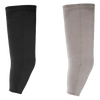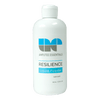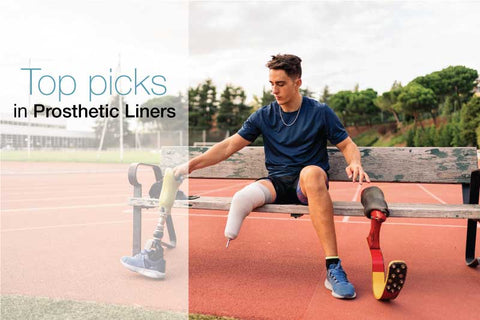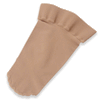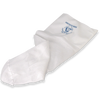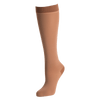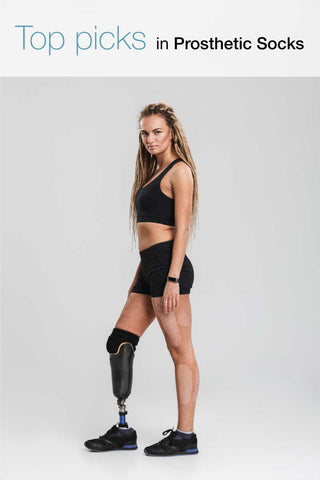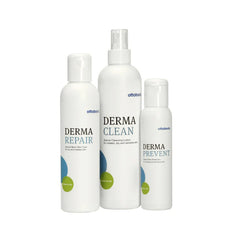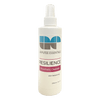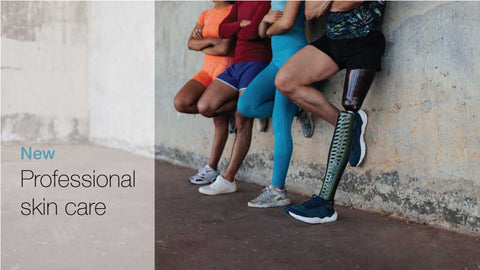Skin Conditions After Limb Loss: What You Need to Know
Reading Time: 10 minutes
Skin disease is one of the most common long-term medical problems people with limb loss encounter after amputation. These skin issues are often found on the residual limb—a result of mechanical breakdown from wearing a prosthetic limb, inflammation, or infection. This is why dermatologists play a crucial role in your healthcare team: they help prevent prosthetic abandonment by keeping the skin on the residual limb healthy.

A 2011 Amputee Coalition article reported that approximately 75% of amputees using a lower limb prosthesis experience skin problems. In general, people living with limb loss and limb differences experience nearly 65% more dermatologic concerns than the general population.
One reason for such high numbers is that the environment within a prosthetic socket is prone to high humidity and increased exposure to bacteria. According to a 2001 study of 97 individuals with above-knee limb loss published in Prosthetics and Orthotics International, some of the most common issues associated with the use of prosthetic sockets include heat and sweating in the socket (72%), as well as sores and skin irritation from socket use (62%).
Below are some common skin conditions among people who use prosthetic limbs, along with information on how to recognize these issues, available treatment options, and how to prevent the development of these skin conditions in the future.
Skin Conditions
Acroangiodermatitis
-
This issue arises from an improperly fitting prosthetic socket, which can lead to circulation problems. Some common signs include itchy and painful red bumps, patches, or lumps on the skin. Treatment options include making adjustments to the prosthetic limb or prescribing oral dapsone and/or topical steroids. For long-term management, options like ablative therapy or surgery may be considered.
Allergic contact dermatitis
-
This problem happens when someone is allergic to the materials in a prosthetic socket or sock liner. Common signs of this allergy include red, itchy rashes in the area that touches the skin. In more severe cases, the irritation can spread beyond that spot. To treat allergic contact dermatitis, people can use creams with steroids and moisturizing lotions. For long-term relief, it's important to avoid anything that causes the allergy and to test any new products on a small skin area first.
Bacterial folliculitis
-
When the hair on a residual limb rubs against the socket or sock too much, it can lead to a skin issue called bacterial folliculitis. This condition shows up as small pus-filled bumps surrounded by redness. To treat it, it's important to minimize heat and friction in the area. If the symptoms are severe, a doctor may prescribe topical or oral antibiotics. For those who frequently experience this issue, getting laser hair removal might be a helpful long-term solution.
Callus
-
A callus forms when there is extra skin growth due to friction, which can happen when using a prosthetic limb. You might notice a thickened spot or bump where the prosthetic rubs against your skin. To treat a callus, a doctor can gently file down the thickened skin using tools like a pumice stone, nail file, or washcloth. They might also use a special patch with salicylic acid to help soften the callus. For a long-term solution, it's best to adjust the fit of the prosthetic device.
Eczema
-
Eczema occurs when the immune system becomes overactive. Common signs include itchy patches of skin that may be red and dry. Doctors often recommend using topical steroids and calcineurin inhibitors to help manage the symptoms. For ongoing care, your doctor might suggest using topical steroids intermittently to maintain skin health.
Epidermal inclusion cyst
-
This is a fluid-filled lump, filled with a substance known as keratin, under the skin. It may feel tender, and sometimes the cyst can burst and leak fluid. Treatment options include antibiotics, draining the cyst, or surgical removal. For ongoing care, your doctor might suggest adjusting your prosthesis. Good hygiene can also help prevent this issue.
Furunculosis
-
Furunculosis occurs when a hair follicle is infected, often by a bacteria called Staphylococcus aureus. It manifests as painful, red bumps on the skin. Treatment usually involves topical antibiotics; if the condition is severe, a doctor may need to cut open the bump and drain it. To help prevent furunculosis, it's important to maintain good hygiene and avoid shaving hair in the area. Instead, laser hair removal is recommended.
Intertriginous dermatitis
-
This skin condition occurs because of too much sweating. You might notice red bumps and patches, especially in areas like the skin in contact with the prosthetic limb or the groin or where skin folds occur. To treat it, it's important to keep the area clean, use drying powders, and apply topical steroids. For long-term care and prevention, adjusting your prosthetic limb and reducing excessive sweating with Botox can be helpful.
Irritant contact dermatitis
-
Exposure to irritants can trigger contact dermatitis but can also be induced by sweating and friction. Symptoms usually show up right after contact and include red, itchy skin limited to the area touched by the irritant. To treat it, you can use topical steroids, barrier creams, and moisturizers. For long-term care, avoiding anything you know irritates your skin is crucial. In some cases, treatments like Botox injections or laser hair removal can also be beneficial.
Negative pressure hyperemia
-
This condition occurs when there are problems with blood and lymph flow in the limbs. It often appears after changes in limb size and is characterized by red, tender areas that can be clearly defined. To treat it, your doctor may recommend taking a break from using your prosthetic limb and applying moisturizer regularly. To help prevent this condition from happening again, it’s important to manage your weight, treat any swelling, and get your prosthesis adjusted as needed.
Psoriasis
-
Psoriasis occurs when the immune system is activated, often in response to trauma, leading to a skin condition. The symptoms include itchy, red patches of skin that have a scaly surface. Treatment options include topical or oral steroids, mild tar treatments, and a combination of psoralen with UVA light therapy. For long-term management, adjusting your prosthesis to minimize injury to the prosthetic limb is essential. Additionally, treating other affected areas is crucial for clearing up the skin, especially on the residual limb.
Pyoderma
-
This problem occurs when there is a bacterial infection, often caused by staphylococci or streptococci. Symptoms might include small red spots that become blisters and then form a honey-colored crust. Depending on the severity of the infection, this condition is treated with oral or topical antibiotics. Good hygiene practices can help prevent pyoderma in the future.
Skin malignancy
-
Skin malignancy can arise when the immune system is weakened. Some signs include squamous cell carcinoma (SCC) and, less commonly, basal cell carcinoma (BCC), verrucous carcinoma, or lymphangiosarcoma. Treatment options typically involve surgery to remove the cancer, chemotherapy, and/or radiation therapy. For ongoing care, it’s important to have an annual checkup with your dermatologist to monitor your skin’s health.
Tinea infection
-
Tinea infection occurs when there is a lot of humidity and sweat gets trapped on the skin. It can appear as itchy, scaly patches. Antifungal ointment can help treat it. To prevent this infection, it's important to reduce sweating, and Botox injections might be a helpful option.
Traumatic neuroma
-
Traumatic neuromas occur when a nerve is cut. They appear as small, slowly growing lumps that can be tender and may look red or bluish. Treatments include surgery to remove the lump or procedures to reconnect the nerve, like targeted muscular reinnervation (TMR). To help keep this condition under control, it's also a good idea to have an annual checkup with your dermatologist.
Ulcer
-
Skin ulcers can occur due to pressure from wearing a prosthetic limb or bacterial infections. You might notice symptoms like pain and redness, especially over bony areas, and in severe cases, there could be damage to the skin layers. To treat these ulcers, you can try light compression and keep the affected limb elevated. Doctors often prescribe antibiotics to fight infections, and in some cases, they may need to remove dead tissue, a process called debridement. For long-term care, it’s important to have your prosthetic limb adjusted. Your doctor might also recommend taking zinc supplements or checking for other underlying problems, such as circulation issues or abnormal bone growth.
Verrucous hyperplasia
-
This condition occurs when a poorly fitting prosthetic limb causes a vascular disorder. Symptoms include a warty or bumpy appearance on the end of the residual limb. To treat this condition, it's important to adjust the prosthesis fit, paying special attention to how it presses against the end of the limb. Making sure the prosthetic fits correctly is key for long-term care.
Yeast infection
-
The possibility of getting a yeast infection increases with increased humidity and sweat retention, both of which can be found within the prosthetic limb. This infection looks like bright red areas on the skin, often with small bumps and patches. Dermatologists typically treat it with medications like nystatin or azoles. To prevent yeast infections from coming back, it’s important to keep sweating in the prosthetic limb to a minimum. One option that might help with this is Botox injections.
Conditions that raise skin disease risk
Certain health issues, in addition to exposure to a humid environment within a prosthetic socket, can increase the risk of developing these skin conditions. For instance, individuals with diabetes or peripheral vascular disease are more prone to skin issues because their blood circulation is often poor.
Rare skin disorders can also arise due to the effects of amputation on blood and lymph flow in the residual limb. These conditions, which include acroangiodermatitis, bullous pemphigoid, granulomatous lesions, skin cancers, and verrucous hyperplasia, may occur as the area becomes less resilient and struggles with proper immune responses.
It’s essential to recognize that skin issues on the residual limb aren’t just an acute problem. A study from 2012 looked at 247 veterans who lost their limbs during the Vietnam War and found that nearly half (48.2%) reported having skin problems more than 38 years after their amputation. And about one-quarter of these veterans had skin issues about half the time, which caused 56% of them to limit or completely stop using their prosthetic limbs at least a year before the study.
Additionally, other post-amputation complications can also indirectly lead to skin problems. A 2007 study discovered that up to 65% of military amputees from Iraq and Afghanistan developed heterotopic ossification—a condition that sees bones form in places they shouldn’t. This condition can cause the prosthesis to fit poorly, leading to skin breakdown.
Mental health is another important factor. A 2014 study found that anxiety and depression significantly affect the quality of life for those who have lost limbs. If these mental health issues aren’t addressed, they can result in poor hygiene and maintenance of the residual limb and prosthesis, mainly due to a lack of energy and motivation. And it has been well-studied that keeping the residual limb and silicone liners clean can help reduce skin problems.
The bottom line
Skin problems after losing a limb can impact your quality of life and ability to use prosthetic devices properly. It’s important to recognize different skin issues, from acroangiodermatitis to irritant contact dermatitis, so that you can get help early on. If you or someone you know is dealing with any skin issue, it’s crucial to reach out to your dermatologist for the right treatment and prevention.

